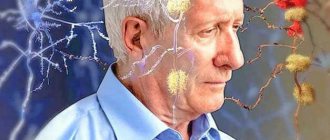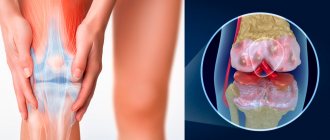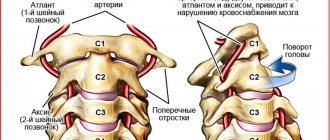Types of sclerosis
Clinicians distinguish several types of pathology:
- Atherosclerosis. The disease is characterized by the presence of “cholesterol plaques” on the walls of blood vessels.
- Multiple sclerosis. It occurs quite often in people over 70 years of age. It manifests itself as a violation of neural communication between organs, tissues and brain cells.
- Thrombosclerosis. Characterized by the occurrence of blood clots, adhesions, and hematomas.
- Senile sclerosis. This type is caused by changes occurring in the structure of the brain.
- Pneumosclerosis. It is rare and develops as a result of damage to the nerve cells of the lungs.
- Autoimmune sclerosis. It develops against the background of damage to the myelin sheath of the nerve fibers of the spinal cord and brain.
Despite the wide variety and complex course of the pathology, medicine has modern means of diagnosing it.
Multiple sclerosis
Herpes
2857 12 July
IMPORTANT!
The information in this section cannot be used for self-diagnosis and self-treatment.
In case of pain or other exacerbation of the disease, diagnostic tests should be prescribed only by the attending physician. To make a diagnosis and properly prescribe treatment, you should contact your doctor. Multiple sclerosis: causes, symptoms, diagnosis and treatment methods.
Definition
Multiple sclerosis (multiple sclerosis) is a chronic, progressive neurodegenerative autoimmune disease of the central nervous system that affects the brain, spinal cord and optic nerves.
Causes of multiple sclerosis
Most nerve fibers are covered with a myelin sheath. The brain sends electrical impulses along nerves to different parts of the body. These impulses control all our voluntary and involuntary movements. Healthy nerves are isolated with the help of a myelin sheath, which is a protective layer that provides nutrition to the axon, maintains its structure, protects it from damage, and accelerates the transmission of nerve impulses.
In multiple sclerosis, a person's own immune system mistakenly attacks and destroys the myelin sheath of nerve fibers.
In the area of myelin loss, scar connective tissue forms, which can distort or completely block transmitted impulses. For some time, the nervous system compensates for the disruptions, but as the disease progresses, the severity of symptoms steadily increases from mild numbness of the limbs to paralysis and/or blindness.
The term “multiple sclerosis” means the presence of multiple scar lesions (or demyelinating plaques) scattered in different parts of the brain and spinal cord.
The reason why immune cells begin to attack the nerve fibers of their own body is still unknown. There is an opinion that the development of the disease can be influenced by many factors: genetic predisposition, active and passive smoking, vitamin D deficiency, exposure to retroviruses, human herpes virus, in particular Epstein-Barr, bacterial infections (staphylococci, streptococci), high salt content in foods nutrition, poor environment, brain injuries (concussions, bruises), damage to the spinal column, excess weight (especially in adolescents and children), stress, some autoimmune diseases. Residents of northern regions and representatives of the Caucasian race are at increased risk of developing multiple sclerosis.
The disease is most often diagnosed at the age of 20–45 years, but can also occur in children. Men get sick 2 times less often than women, but it is in them that the pathology is more severe and less responsive to treatment.
Classification of the disease
There are some typical flow options
multiple sclerosis:
- Remitting course is the most common variant in the onset of the disease. It is characterized by periods of exacerbations, alternating with periods of remission (with complete or incomplete restoration of functions in the periods between exacerbations), and the absence of an increase in symptoms during periods of remission. In many patients, the remitting course subsequently turns into secondary progression (with or without exacerbations);
- Progressive course:
- primary progressive – from the very beginning of the disease, for at least one year, there is an increase in the severity of the symptoms of the disease without periods of improvement;
- secondary progressive - the severity of the symptoms of the disease increases for at least 6 months without stabilization or improvement after the relapsing phase of the disease, progression with or without exacerbations is possible.
Multiple sclerosis is also classified by disease activity
- exacerbation or detection of new lesions in the brain and/or spinal cord during an MRI examination. The following forms can be distinguished:
- active multiple sclerosis (in the presence of exacerbations or signs of disease activity according to MRI);
- inactive multiple sclerosis (without exacerbations and without signs of activity according to MRI);
- multiple sclerosis with progression (new lesions are identified);
- multiple sclerosis without progression (new lesions of the nervous system have not been identified).
There are also several special forms of the disease that require aggressive treatment methods
:
- the malignant form (Marburg disease) is characterized by very rapid progression without periods of remission, in the most severe cases it can lead to the death of the patient;
- an aggressive or rapidly progressive form, in which two or more episodes of exacerbation are observed during the year, leading to an increase in the level of disability;
- the highly active form is characterized by two or more exacerbations per year and a significant increase in lesions of the nervous system according to MRI.
Symptoms of multiple sclerosis
The very first symptoms appear when about 50% of the nerve fibers are already affected - that is, at first the disease does not manifest itself in any way. This is explained by the fact that healthy brain cells take over the function of the affected areas.
Signs of multiple sclerosis depend on the location of the main part of the pathological foci.
As new areas are affected, the symptoms increase and become more diverse. Damage to the cerebellum and its pathways:
severe tension in the legs or arms (due to increased muscle tone), possible paralysis, poor coordination of movements, staggering when walking, involuntary movements, tremor of the arms and legs, impaired speech function, dizziness.
Optic nerve damage:
decreased vision in one eye up to complete blindness; black dot in the center of the field of view; a feeling of cloudy glass, a veil in front of the eye - these are manifestations of retrobulbar neuritis (pathology of the optic nerve in the area behind the eyeball as a result of damage to its myelin sheath). There is a disturbance in the movement of the eyeball, and double vision (diplopia) develops.
Spinal cord damage:
constant tiredness and fatigue, loss of bowel and bladder control, constipation and urinary retention, changes in sexual function, radiculopathy, Lhermitte's sign (when you bend your head forward, there is a sensation of electric current passing through the spine, sometimes radiating to the limbs), burning sensation or pain in response to touch, tingling or numbness in the limbs, development of spastic paraparesis.
Brain stem damage:
weakness or spasm of the facial muscles, intermittent numbness of one half of the face, central or peripheral paresis of the facial nerve, hearing loss, decreased taste sensitivity.
Damage to the cerebral hemispheres:
decreased memory and attention, speed of neuropsychological tests, behavioral disorders, excessive anxiety, bad mood, depression or euphoria.
After taking a hot bath and under the influence of a hot climate, the patient's condition temporarily worsens.
This must be taken into account and try to avoid overheating, which can provoke an attack. Nerve fibers deprived of their myelin sheath are extremely sensitive to increased temperature.
Diagnosis of multiple sclerosis
In general, the clinical manifestations of the disease are very diverse, which makes diagnosis difficult. Two main clinical signs confirming the presence of multiple sclerosis:
- symptoms appear in various parts of the central nervous system;
- the presence of at least two attacks of the disease, the occurrence of which is separated in time by a period of at least one month.
The diagnosis of “multiple sclerosis” is made last, that is, after excluding other causes of such multifocal brain damage.
Diagnostic methods:
Assessment of complaints, symptoms, clinical disorders.
During a neurological exam, the doctor checks nervous system function such as reflexes, balance, coordination and vision, and looks for areas of numbness. Ophthalmological examination with mandatory assessment of visual acuity, visual fields, condition of the fundus.
For a patient suspected of having multiple sclerosis, the following laboratory tests are recommended to assess the general condition of the body and determine the possibility of prescribing subsequent therapy:
- detailed clinical blood test;
Causes
The main causes of senile sclerosis:
- Biochemical processes that negatively affect brain cells. As the body ages, the transmission of impulses between neurons decreases.
- Cerebrovascular accident. With age, the permeability of the bloodstream and the elasticity of blood vessels decrease, which contributes to the death of neurons.
- Slowing down neuronal cell regeneration. Negatively affects the functioning of the central nervous system and overall health.
In some cases, the development of the disease is due to a genetic predisposition. However, in most cases, the occurrence of pathology is facilitated by processes associated with age-related changes occurring in the body of older people.
Drug therapy
The following groups of drugs are prescribed. Our specialists at the Yusupov Hospital will select the most suitable combination based on your medical history and examination.
- statins;
- antiplatelet agents;
- nootropics to improve cerebral circulation;
- antihypertensive drugs and drugs that lower blood sugar (if there is a concomitant pathology).
Statins are drugs that reduce certain fractions of lipids (in particular low- and very low-density lipoproteins), which are deposited on the walls of blood vessels. Antiplatelet agents increase blood clotting to prevent the accumulation of red blood cells on the atherosclerotic plaque. Thus, these two groups of drugs protect against recurrent sclerosis and the risk of stroke.
Nootropic drugs, in turn, have a stimulating effect on the integrative function of the brain. By regulating energy processes in cells, they fight hypoxia and also improve blood supply to the central nervous system. Taking nootropics improves the trophism of nervous tissue, which leads to increased brain activity, activation of operational and long-term memory and restoration of hemodynamics after a stroke or brain injury.
Antihypertensive therapy aims to lower blood pressure below 140/90 to prevent complications.
Symptoms
Sclerosis negatively affects the psycho-emotional state of an elderly person and often leads to prolonged depression. The pathology is manifested by the following symptoms:
- Extreme touchiness.
- The assessment of current events is exclusively negative.
- Progressive forgetfulness.
- Joint pain.
- Migraine.
- Increased blood pressure and, as a result, the occurrence of cardiovascular diseases.
If these symptoms appear frequently, this is a reason to consult a specialist, since only early diagnosis and timely treatment will help slow down the destruction of brain cells.
When the disease is diagnosed at a late stage, the prognosis for improvement is unfavorable. This is due to the occurrence of an irreversible process of destruction of brain neurons. In this case, an elderly person experiences the following symptoms:
- Dementia.
- Disorientation.
- Aggressiveness.
- Inability to perceive information.
- Anxiety, causeless anxiety.
- Apathy, depression, increased drowsiness.
- Senile egoism.
- Inability to reason logically.
The appearance of these signs indicates the presence of deep senile sclerosis in an elderly person. At this stage of the disease, neuron cells die off quite rapidly, which precedes such mental manifestations as hallucinations and delusions. In some cases, a person may lose control of himself.
Diagnostics
Correct treatment of the pathology is possible only after the following diagnostic measures:
- MRI and CT of the brain.
- Complete blood test (sugar, creatinine, blood electrolytes, vitamin B1 level).
- Study of cerebrospinal fluid.
- Blood test for thyroid hormones.
In addition, a neurologist examines the medical history and collects information about a possible genetic predisposition to the development of this pathology.
Treatment
Treatment of senile sclerosis requires an integrated approach. Therapy is quite long and is often accompanied by the participation of a cardiologist, neurologist and psychotherapist. Only in this case is there a high probability of stopping the destruction of brain neurons.
Before prescribing treatment, the specialist finds out the cause of the degradation of brain cells. Therapy for senile sclerosis includes the use of medications, effective folk remedies, psychotherapist sessions, dietary nutrition, physical activity and normalization of the daily routine.
Drug treatment
For senile sclerosis, the following groups of drugs are prescribed:
- Psychostimulants. In most cases, therapy is based on taking psychostimulants. Drugs in this group have a stimulating effect on parts of the brain.
- Nootropics. These drugs have a positive effect on the integrative functions of the brain, suppressing aggressive manifestations.
- Tranquilizers. Medicines in this group help reduce excessive emotional excitability and anxiety.
In addition to drug therapy, psychotherapeutic treatment is recommended for an elderly person suffering from sclerosis. Sessions with a neuropsychiatrist promote positive thinking and help prepare for long-term treatment.
Folk remedies
Effective folk remedies can be used as part of the complex treatment of senile sclerosis. Tinctures from rowan bark, elecampane, clover, heather decoction, garlic oil, onions with honey have a beneficial effect.
Before using such products, you should consult your doctor.
Other methods
Positive dynamics in treatment depends not only on the timely use of medications and folk remedies. Factors such as:
- Interest in life. The involvement of an elderly person in society and family affairs has a beneficial effect on his psycho-emotional state.
- Elimination of stress. To avoid exacerbations of sclerosis, it is necessary to protect the elderly from worries and stress, since this significantly impairs memory.
- Memory training. Reading is one of the most effective ways to train memory at any age. After reading a book or article, it is necessary to analyze what you read and highlight the most important episodes.
- Planning. Thought processes in any manifestation effectively affect the functioning of the brain in old age. Daily brain training can include making a plan for several days. This could be a trip to the store, household chores, hobbies, etc.
- Concentration of attention. Mastering computer literacy, foreign languages, learning poems and songs will help activate your memory. When absorbing significant volumes, it is necessary to take a break of at least two hours. This will allow you to better assimilate new information.
Treatment of senile sclerosis is a long process, so relatives must support the elderly person. This requires providing not only emotional support, but also monitoring the intake of medications and compliance with all recommendations of the attending physician.
Why do cognitive impairments occur?
The main reason is organic. Cognitive functions are impaired when their material carrier, the nerve chain, is damaged. It consists of nerve cells - neurons, their processes and contacts - synapses with which they communicate with each other. The long extension of a neuron—the axon—conducts a signal over a distance. Its terminal section branches and forms synapses for communication with other neurons.
The pathological processes of multiple sclerosis can disrupt nerve chains [6]:
- Damage to myelin , the insulating substance of nerve fibers.
Along perforated pathways, impulses travel slower and require more energy. Cognitive processes associated with these pathways also slow down. Myelin can be restored, but connective tissue often “puts a patch” faster than it. The fiber regains physical integrity, but its function is not corrected. Plaques prevent the axon from conducting signals and forming nerve connections. - Atrophy of the axon axis may occur following the destruction of its membrane, as it becomes more vulnerable and its nutrition is disrupted. In cognitive terms, this means that existing connections may be disrupted, and potential ones may not be formed.
- Atrophy of gray matter - the neurons themselves and supporting cells - also entails cognitive impairment. They are associated with a decrease in brain volume in general and with thinning of the gray matter of the cortex. The fluid-filled ventricles in the brain, on the other hand, enlarge. Depending on the type of multiple sclerosis, different areas are identified, damage to which most often leads to problems in cognition [7]. The mechanisms of atrophy may be associated with the destruction of fiber myelin, or may have other reasons [8].
- Impaired cerebral blood supply is detected in the early stages of the disease, regardless of the type of course. Affects both foci of demyelination and apparently normal areas. It often precedes brain atrophy in MS. Some researchers have linked deterioration in brain metabolism and cognitive impairment [9].
Scientists disagree about which areas of the body are damaged and lead to dementia and other cognitive disorders. It is more or less accurately possible to link monofunctional disorders and certain parts of the brain. For example, if there are areas of demyelination or atrophy in Broca's area, there is a high likelihood that speech problems will arise. Some researchers believe that memory impairment is primarily associated with the destruction of myelin in the areas of the corona radiata, insula, and hippocampus. Still, it is believed that the severity and nature of cognitive impairment are associated not so much with the location of the lesions, but with their size and number [3–5].
Multiple sclerosis and cognitive impairment are linked by the following patterns [10]:
- As the duration of the disease , foci of damage in the nervous tissue accumulate and expand. At the same time, cognitive dysfunction also increases.
- The degree of disability with a decrease in the speed of thinking and attention span. Time spent on completing tasks increases.
- During exacerbations of multiple sclerosis, a person is more likely to make mistakes at work. Often, exacerbation is accompanied by vision problems. This also affects the number of errors.
- Cognitive impairments are detected even at the stage of a clinically isolated syndrome. They are most pronounced in patients with primary progressive and progressive forms with exacerbations [3].
The brain is able to adapt and restore neural connections with the help of neighboring neurons. The more extensive the neural network is, the easier it is to establish communications. The cerebral reserve, which compensates for damaged circuits, is greater in people with high intelligence and those accustomed to mental work [7].
In addition to pathological processes, other factors also contribute to the functioning of the brain in MS [4]:
- Age - over the years, neurons that are used less intensively are increasingly destroyed. As a result, the cerebral reserve is depleted. In areas of the brain such as the memory center - the hippocampus - neurons continue to renew into old age. However, the blood flow no longer feeds them as actively, so fewer nerve connections are formed. In addition, in old age, one patient may experience two cerebral diseases simultaneously.
- Low intellectual activity increases the risk of cognitive impairment in MS. Education, the intensity of mental work, and initial thinking abilities also matter.
- Psycho-emotional disorders - depression, anxiety, chronic fatigue, insomnia, etc. affect brain processes. Cognitive impairment often occurs as a consequence of these problems. The temporary factor is stress .
- Vascular pathologies , including arterial hypertension, previous strokes and various heart diseases, can disrupt the microcirculation of the brain and cause cognitive impairment. Diabetes mellitus, especially type II, may act through vascular or molecular mechanisms [7].
Diagnosis of cognitive impairment
The severity and nature of cognitive problems do not always depend on physical damage to the brain. You can't judge them based on MRI results alone. Moreover, white and gray matter may appear normal, but neural connections may be disrupted [10].
Cognitive disorders largely determine aspects of personality: character, subjective attitude, predisposition to a particular mental state [4].
The first step in diagnosis is to listen to yourself. Pay attention to the slightest changes in mental activity. If you have suspicions, but you are not sure, ask your loved ones to watch you from the side. Pay attention to other symptoms of MS: depression, anxiety, apathy, insomnia, fatigue.
Share the results with your neurologist. If necessary, he will refer you to a clinical psychologist for evaluation. In addition to the symptoms you notice, age, length of illness, the presence of vascular disorders, psycho-emotional disorders, and relapses of MS will be taken into account [11].
Medical diagnosis of cognitive impairment in MS may include tests [12] *:
- MoCA (Montreal Cognitive Assessment Scale) is a 10-minute test to identify dysfunction in various cognitive domains [13];
- PASAT is part of the MSFC test. Attention, information processing speed and working memory are assessed in 15 minutes;
- oral SDMT - measures the same as the PASAT. The test takes about 5 minutes. As an analogue, the two-minute PST test is used;
- Stroop test - determines the stability and selectivity of attention. Requires 5 minutes;
- BRB-NT, MACFIMS and BICAMS methods are used for more detailed diagnostics.
The tasks given are varied. They are asked to perform some action, such as cutting paper or combing their hair. Tests include tasks for counting, drawing, choosing figures, memorization, orientation in space and time. It is required to give objects a name, repeat a phrase, and build an associative series [12–13].
Prevention
You can avoid the occurrence of senile sclerosis if you follow the following recommendations:
- Active lifestyle. A daily walk in the fresh air is a must in an elderly person’s daily routine.
- Positive thinking. Positive emotions are as essential to brain function as oxygen.
- Maintaining a daily routine. An important condition for active brain function in old age is sleep for at least 8 hours.
- Memory training. Watching educational programs, learning a foreign language, memorizing poetry, etc.
- Compliance with drinking regime. Drinking 1.5-2 liters of water per day helps cleanse blood vessels.
- Diet. In old age, it is important that the diet consists of foods rich in protein, fiber and Omega-3. It is also necessary to enrich the diet with vegetables and fruits.
Compliance with these rules promotes the active functioning of brain cells and helps preserve memory for many years.







